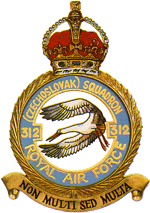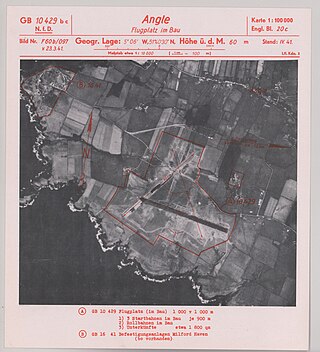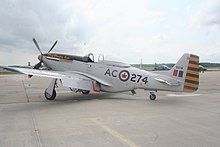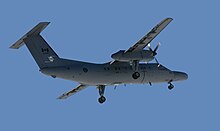
Royal Air Force Digby otherwise known as RAF Digby is a Royal Air Force station located near Scopwick and 11.6 mi (18.7 km) south east of Lincoln, in Lincolnshire, England. The station is home to the tri-service Joint Service Signals Organisation, part of the Joint Forces Intelligence Group of Joint Forces Command. Other units include the RAF Aerial Erector School, No. 54 Signals Unit and No. 591 Signals Unit.

No. 303 Squadron RAF, also known as the 303rd "Tadeusz Kościuszko Warsaw" Fighter Squadron, was one of two Polish squadrons that fought during the Battle of Britain along with No. 302 Squadron, of 16 total Polish squadrons during the Second World War. Flying Hawker Hurricanes, the squadron claimed the largest number of aircraft shot down of the 66 Allied fighter squadrons engaged in the Battle of Britain, even though it joined the fray two months after the battle had begun.

Number 54 Squadron is a squadron of the Royal Air Force based at RAF Waddington, Lincolnshire. On 1 September 2005, it took on the role of Intelligence, Surveillance and Reconnaissance (ISR) Operational Conversion Unit, and is now the Advanced Air ISTAR Academy, responsible for training all RAF crews assigned to the MQ-9A Reaper, Protector RG1 (MQ-9B), Shadow R1/R2, RC-135W Rivet Joint and Poseidon MRA1. It also controls the RAF ISR Warfare School (ISRWS) who run the Qualified Weapons Instructor Intelligence, Surveillance and Reconnaissance and QWI Reaper Courses.
No. 118 Squadron was a squadron of the British Royal Air Force. Originally formed in 1918, it served as a fighter squadron in the Second World War, flying Spitfires and Mustangs. It flew jet fighters as part of RAF Germany in the 1950s, and Bristol Sycamore helicopters in Northern Ireland before finally disbanding in 1962.

438 "City of Montreal" Tactical Helicopter Squadron is a unit of the Royal Canadian Air Force. The squadron operates the Bell CH-146 Griffon tactical helicopter from the Hartland de Montarville Molson Hangar of CFB St. Hubert in Quebec, Canada. Its tasks include armed and unarmed tactical utility transport, training aircrew personnel in basic and advanced aviation tactics, technical training of groundcrew personnel and flight engineers and the periodic maintenance of CH-146 fleet aircraft. They also include as residual capabilities search and rescue, reconnaissance and support to federal, provincial and local law enforcement agencies. A "total force" unit composed of members of the Regular Force, and both full time and part time reservists, the squadron is part of 1 Wing at CFB Kingston Ontario.

The Battle of Britain Memorial Flight (BBMF) is a Royal Air Force flight which provides an aerial display group usually comprising an Avro Lancaster heavy bomber and two fighters, a Supermarine Spitfire and a Hawker Hurricane. The aircraft are regularly seen at events commemorating the Second World War and upon British State occasions, notably Trooping the Colour, celebrating Queen Elizabeth II's 80th birthday in 2006, and the wedding of Prince William and Catherine Middleton in 2011, and at air displays throughout the United Kingdom and Europe.
Irving Farmer 'Hap' Kennedy was a Canadian fighter pilot in the Royal Canadian Air Force (RCAF) during the Second World War. He was one of Canada's highest-scoring aces of the war, with 10 solo and 5 shared aircraft destroyed, and 1 probably destroyed.

No. 312 Squadron RAF was a Czechoslovak-manned fighter squadron of the Royal Air Force in the Second World War.

406 "City of Saskatoon" Maritime Operational Training Squadron is a Royal Canadian Air Force (RCAF) unit of the Canadian Armed Forces. Based at 12 Wing Shearwater since 1972, it is responsible for crew training on the Sikorsky CH-148 Cyclone since summer of 2016. The squadron was formed during World War II as part of RAF Fighter Command.

No. 607 Squadron is an auxiliary squadron of the Royal Air Force. It was formed in 1930 as a bomber unit in the Auxiliary Air Force and changed in 1936 to the fighter role. It fought in that role during the Second World War in Europe and Asia. After the war, in 1946, the squadron reformed as a fighter unit. Awarded the title Royal Auxiliary Air Force by King George in 1947, 607 Sqn was disbanded with all the other flying units of the RAuxAF on 10 March 1957. It reformed on 5 January 2015, as a General Service Support Squadron (GSS).

Royal Air Force Fairwood Common, or more simply RAF Fairwood Common, is a former Royal Air Force sector station located on Fairwood Common, on the Gower Peninsula, to the west of Swansea. It is now the location of Swansea Airport.

403 "City of Calgary" (Helicopter) Operational Training Squadron is a squadron of the Royal Canadian Air Force (RCAF) located at Canadian Forces Base Gagetown. It is equipped with CH-146 Griffons and provides operational aircrew training to the crews who will fly the helicopter. The squadron also conducts operational test and evaluation, develops aviation tactics and carries out operations in support of the 1 Wing mission. It also supports the local Army requirements of the Combat Training Centre. It was founded as No. 403 Squadron RCAF.

The Supermarine Spitfire, the only British fighter to be manufactured before, during and after the Second World War, was designed as a short-range fighter capable of defending Britain from bomber attack and achieved legendary status fulfilling this role during the Battle of Britain. According to fighter ace J.E. "Johnnie" Johnson it was the best conventional defensive fighter of the war.

Royal Air Force Angle or more commonly RAF Angle, is a former Royal Air Force station located on the Angle Peninsula Coast, 8 miles (13 km) west of Pembroke, Pembrokeshire, Wales. It was operational from 1 June 1941 to 11 July 1946, having been used by both the Royal Air Force and the Royal Navy.

No. 412 Transport Squadron is one of three Royal Canadian Air Force (RCAF) transport squadrons attached to Ottawa, Ontario. The squadron operates with a strength of about 29 out of the Pilot Officer John Gillespie Magee, Jr. Annex.The Annex officially opened on January 11, 1995.

No. 401 Tactical Fighter Squadron, a.k.a. "City of Westmount" Squadron, is a Royal Canadian Air Force squadron based at CFB Cold Lake. During World War II it was a fighter squadron and is notable for having fought in the Battle of Britain. Postwar, the squadron operated in Canada as an auxiliary squadron, reserve squadron and a helicopter and training squadron. In 2015 it was reactivated as a tactical fighter squadron, flying the McDonnell Douglas CF-18 Hornet.

No. 411 "City of York" Squadron RCAF was a Second World War Royal Canadian Air Force squadron that operated as part of RAF Fighter Command in Europe with the Supermarine Spitfire.

440 Transport Squadron is a unit of the Canadian Armed Forces under the Royal Canadian Air Force. It is part of 8 Wing and works closely with Joint Task Force (North) in Yellowknife, Northwest Territories.

787 Naval Air Squadron was a Fleet Air Arm (FAA) naval air squadron of the United Kingdom’s Royal Navy (RN) which disbanded in January 1956. It formed in March 1941, at HMS Heron, RNAS Yeovilton, out of 804 Naval Air Squadron as a Fleet Fighter Development Unit. Almost every type of fighter was received by the squadron for testing and evaluation for naval use. A move to RAF Duxford in June 1941 saw it become the Naval Air Fighting Development Unit, attached to the Royal Air Force's Air Fighting Development Unit. The squadron undertook rocket projectile test, continuous development of fighter tactics and even helping Torpedo Bomber Reconnaissance squadrons in evading fighter attack. Post Second World War it continued its trials task and also undertook Rebecca radar trials and ASH, US-built air-to-surface-vessel radar trials.





















